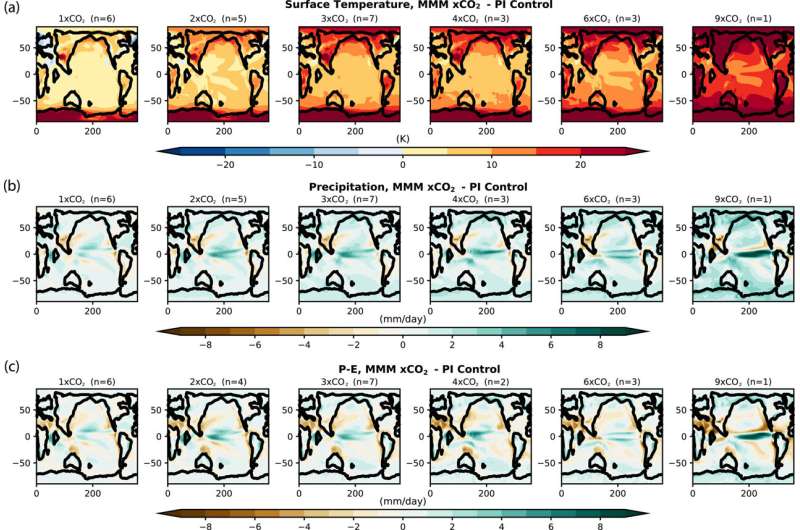June 27, 2023 feature
This article has been reviewed according to Science X's editorial process and policies. Editors have highlighted the following attributes while ensuring the content's credibility:
fact-checked
peer-reviewed publication
trusted source
proofread
56 million-year-old Eocene global warming may indicate a wetter future

Modeling of Earth's response to global warming has suggested dry regions will become more arid and wet regions will experience more precipitation, with an uneven distribution of moisture in the atmosphere. With enhanced seasonality, there will likely be more severe consequences for our remote and urban communities, as well as natural ecosystems.
While there has been some uncertainty over low latitude (tropics, <15° N/S) and mid-latitude (15—30° N/S) hydrological responses to global warming, high latitudes (>60° N/S) are predicted to become wetter and subtropical regions (15°–30° N/S) drier. However, scientists have studied ancient global warming events to suggest that, at least for the subtropics, this may not be the case.
The Early Eocene Climatic Optimum (56–48 million years ago) was one of the warmest intervals of the last 66 million years, with mean global surface temperatures over 14°C warmer than present. Atmospheric carbon dioxide levels were elevated to >1,000 parts per million (ppm; by comparison modern levels are ~400 ppm) and mean sea surface temperature was up to 16°C warmer than pre-Industrial temperatures, while latitudinal temperature gradients (the temperature difference between the equator and poles) peaked at 22°C. Intergovernmental Panel on Climate Change (IPCC) reports predict that Eocene climate could be reached by 2100, under worse-case scenario models.
Researchers at the University of Southampton's School of Ocean and Earth Science and global collaborators have used the Deep-Time Model Intercomparison Project (DeepMIP) to reconstruct global mean rainfall patterns during the early Eocene across the planet. Their research is reported in Paleoceanography and Paleoclimatology.
Meanwhile, physical evidence of the Eocene climate conditions was obtained from palaeontological proxies, these being preserved fossil leaves, pollen and spores. Leaf size and shape in particular can be an extremely useful indicator of moisture levels in the surrounding environment, and oftentimes the preserved leaves can be identified to their nearest modern relatives with assumptions being made that they have similar functions and ecological preferences, Therefore, if Eocene leaves can be matched to leaves that thrive in wetter conditions in the modern day, scientists can assume this was the case millions of years ago too.
The DeepMIP simulations work from the pre-Industrial level up to nine times that CO2 concentration for worse-case scenario models. As greater CO2 concentrations result in enhanced warming, the researchers found that higher global mean surface temperatures correlated with increased mean annual precipitation estimates. This is most noticeable in high latitudes, with models predicting a 9.1% increase in mean annual precipitation with each 1°C increase in temperature, while global average mean annual precipitation increased 2.4% per 1°C warming. Tropical and subtropical mean annual precipitation was still relatively high as well, calculated as >2–4 mm/day.
Overall, the models simulate that when latitudinal temperature gradients are weaker, moisture in the atmosphere in the tropics is less likely to be dispersed across the planet, contributing to more precipitation in these areas. Tropical and high-latitude regions are characterized by positive precipitation and evaporation regimes, leading to wetter conditions, while the subtropics are anticipated to experience opposing negative precipitation and evaporation values, with more aridity. Earth's connected systems make the latter more complex though as humidity and atmospheric circulation interfere with subtropical moisture budgets, resulting in greater precipitation and less evaporation than modeled.
Comparing the simulations to fossil proxy data from vegetation suggests that these models could be underestimating the precipitation levels from past climate change and thus scientists must use a multi-pronged approach to modeling current and future implications of global warming. Importantly though, comparison to global warming events in the deep past offers insights for where we may be headed in the future so humanity can plan mitigation strategies to deal with progressively drier or wetter conditions, depending on where they are in the world.
More information: Margot J. Cramwinckel et al, Global and Zonal‐Mean Hydrological Response to Early Eocene Warmth, Paleoceanography and Paleoclimatology (2023). DOI: 10.1029/2022PA004542.
Journal information: Paleoceanography and Paleoclimatology
© 2023 Science X Network




















